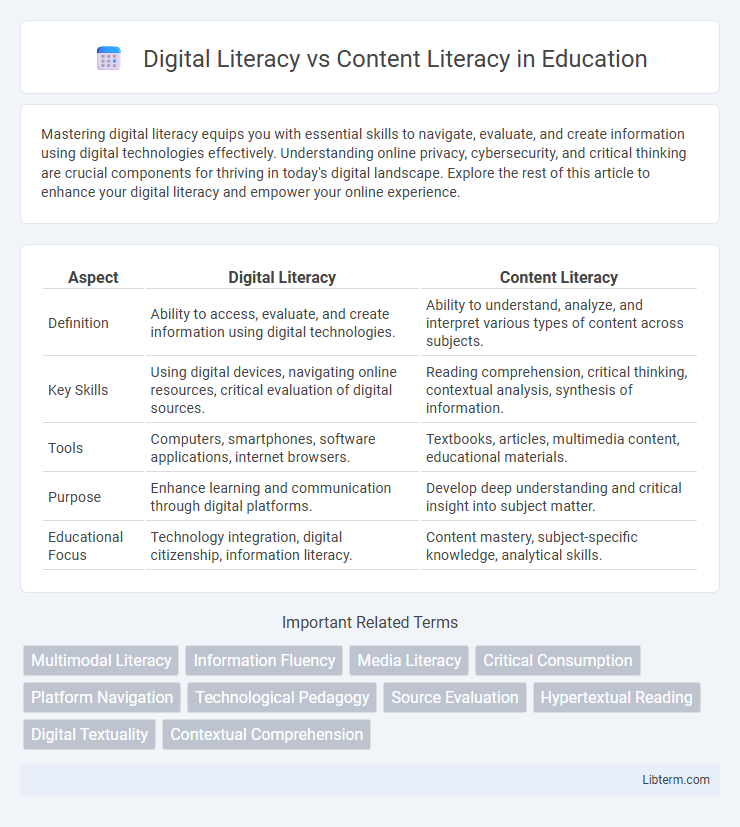Mastering digital literacy equips you with essential skills to navigate, evaluate, and create information using digital technologies effectively. Understanding online privacy, cybersecurity, and critical thinking are crucial components for thriving in today's digital landscape. Explore the rest of this article to enhance your digital literacy and empower your online experience.
Table of Comparison
| Aspect | Digital Literacy | Content Literacy |
|---|---|---|
| Definition | Ability to access, evaluate, and create information using digital technologies. | Ability to understand, analyze, and interpret various types of content across subjects. |
| Key Skills | Using digital devices, navigating online resources, critical evaluation of digital sources. | Reading comprehension, critical thinking, contextual analysis, synthesis of information. |
| Tools | Computers, smartphones, software applications, internet browsers. | Textbooks, articles, multimedia content, educational materials. |
| Purpose | Enhance learning and communication through digital platforms. | Develop deep understanding and critical insight into subject matter. |
| Educational Focus | Technology integration, digital citizenship, information literacy. | Content mastery, subject-specific knowledge, analytical skills. |
Understanding Digital Literacy: A Modern Necessity
Understanding digital literacy involves mastering the ability to effectively locate, evaluate, and create information using digital technologies, which is essential in today's tech-driven world. Digital literacy transcends basic computer skills by emphasizing critical thinking, online communication, and safe internet usage. Developing these competencies enables individuals to navigate complex digital environments, making informed decisions and participating fully in the digital society.
Defining Content Literacy in Today’s World
Content literacy in today's world involves the ability to comprehend, analyze, and critically evaluate information across diverse media platforms, encompassing text, images, and multimedia sources. Mastery of domain-specific knowledge and vocabulary is essential for understanding complex subject matter and engaging with digital content effectively. Developing content literacy enhances critical thinking skills necessary to discern credible information in an era of information overload and misinformation.
Key Differences Between Digital and Content Literacy
Digital literacy emphasizes proficiency with digital tools, platforms, and navigating online environments, while content literacy centers on understanding, analyzing, and interpreting information within various texts. Digital literacy involves skills such as evaluating online credibility and using multimedia resources, whereas content literacy focuses on critical reading, comprehension, and subject-specific knowledge. The key difference lies in digital literacy's technological fluency versus content literacy's deep engagement with textual meaning and context.
The Evolution of Literacy in the Digital Age
Digital literacy encompasses the skills required to navigate, evaluate, and create information using digital platforms, while content literacy focuses on understanding and interpreting the meaning and purpose of specific texts or media. The evolution of literacy in the digital age reflects a shift from traditional print-based skills to multifaceted competencies involving digital tools, critical thinking, and multimedia communication. Mastery of both digital and content literacy is essential for effective participation in today's information-rich, technology-driven society.
Essential Skills for Digital Literacy
Digital literacy essential skills include the ability to navigate digital platforms, critically evaluate online information, and effectively communicate using digital tools. Mastery of technical skills such as operating devices, understanding digital privacy, and managing digital identity is crucial. These competencies form the foundation for digital literacy, distinguishing it from content literacy, which emphasizes comprehension and critical analysis of textual information.
Core Competencies in Content Literacy
Core competencies in content literacy include critical thinking, comprehension, and analysis of information across various media formats. These skills enable individuals to effectively evaluate the credibility, relevance, and purpose of content while integrating knowledge from multiple sources. Mastery of content literacy supports informed decision-making, effective communication, and lifelong learning in a digitally-driven environment.
The Impact of Technology on Traditional Literacy
Digital literacy transforms traditional literacy by integrating skills in navigating, evaluating, and creating content across digital platforms, expanding the scope beyond reading and writing text. The rapid advancement of technology demands proficiency in multimedia comprehension and critical thinking to interpret diverse digital formats, shifting educational priorities. This evolution enhances accessibility but challenges conventional literacy frameworks, requiring new strategies to address digital information's complexity and volume.
Challenges in Teaching Digital and Content Literacy
Teaching digital literacy faces challenges such as rapidly evolving technologies that require educators to continuously update their skills and adapt curricula to diverse digital platforms. Content literacy instruction struggles with integrating critical thinking skills across various subject areas while ensuring students can analyze and synthesize information from multiple sources accurately. Both disciplines demand tailored pedagogical strategies to address varying student backgrounds and the increasing presence of misinformation in digital content.
Integrating Digital and Content Literacy in Education
Integrating digital literacy and content literacy in education enhances students' ability to critically analyze digital information while mastering subject-specific knowledge. Effective implementation involves using digital tools to access, evaluate, and create content across disciplines, fostering both technical skills and deep comprehension. This blended approach prepares learners for complex problem-solving and informed decision-making in the digital age.
Future Trends: Bridging the Literacy Gap
Digital literacy and content literacy are evolving to address the growing demands of the knowledge economy, with future trends emphasizing the integration of AI-driven tools and immersive technologies like AR/VR to enhance comprehension and critical thinking skills. Emerging educational frameworks prioritize personalized learning experiences that bridge the literacy gap by fostering both digital navigation abilities and deep content understanding across diverse media formats. Investments in adaptive learning platforms and equitable access to technology are critical to closing disparities, ensuring learners develop the holistic skills needed for complex problem-solving and informed decision-making in a rapidly digitalizing world.
Digital Literacy Infographic

 libterm.com
libterm.com